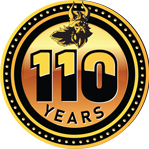Mural honours Ukrainian history
Connor McDowell,
Local Journalism Initiative Reporter
The year was 1931 and Ukrainians from the west side of Rivers were dancing at a new community centre.
It was the opening day of the Taras Schevchenko Hall. Music spilled out from the building at the corner of Second Avenue and Columbia Street, and east-side Ukrainians stood in the street, tapping their toes and wishing they were allowed to join.
The cover charge was $0.35 if you could afford it. But for the east-siders, no entry at any cost. A communication breakdown between the two groups would take another year to resolve. For the time being, second-hand music was OK.
The night on Labour Day so many years ago is one the community is hoping to commemorate with a new mural. The Rivers Train Station Restoration Project commissioned artists to paint Ukrainian-inspired art onto the side of the hall this summer.
Dancers, Pysanksy eggs, and Ukrainian patterning are going up on the side of the building at 580 Second Ave. Painted dancers represent the history of dance classes that took place at the hall, while the eggs and patterning are icons for Ukrainian culture, which thrived in the rural community alongside the construction of the railway.
When asked why it was important to capture this history in Rivers, Donna Morken, member of the Rivers Train Station Restoration Commitee, pointed to the contributions Ukrainians made.
“They built homes here. They worked here. They were part of the growth of the community,” said Morken. “When the Ukranian society closed they gave a lot of money to the train restoration committee. So one way to honour them and to talk about our history was to do a mural.”
The committee exists to upkeep the area’s historic train station, and the surrounding community. The goal is to “connect with the past while creating a vision for the future.”
Morken said many Ukrainian immigrants had lived in the rural Manitoban community after relocating to help build the railway. As Lorna Short wrote for the Manitoba Historical Society, doctors, professors and military members came from the Ukrainian families that settled in Rivers. The hall, which quickly resolved to serve members from east and west Rivers, was a community place that allowed them to thrive.
“The Ukrainian Society and the Taras Schevchenko Hall represented the means by which the Ukrainian population of Rivers over the years were able to maintain and enjoy their cultural heritage.”
It held its status as the hall until 2009, when the society dissolved. Short wrote that the community possibly thrived and declined with the state of the work on the railway.
“The energetic and sizable community that existed in Rivers early in the 20th century slowly declined over the years to the present time when there are sparse few in the town of Ukrainian heritage,” she said. “The hall was kept well maintained for many years but in 2009, the few remaining members decided to dissolve the Ukrainian Society and the building was sold shortly after.”
Today, the building stands in the same place. It has been converted for different uses, including cafe’s, but now is a home for the Zion Pentecostal Church. It is also bigger than when it was first built.
“Many renovations were made,” short added. “Including a balcony designed as a mezzanine for orchestral accommodation, waterworks, washrooms, kitchen cupboards, natural gas in 1965 followed by new flooring, relining the walls and ceiling, new kitchen appliances and reshingling of the roof.”
In the new and loner building today, the history of the old is being painted into the sands of time. Two artists, Erica and Mary Lowe, have been working to capture the history through art so it lives on in the community.
Connor McDowell,
Local Journalism Initiative Reporter
Brandon Sun




